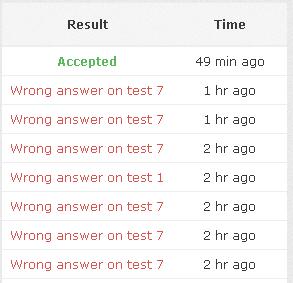codeforces 193 D Two Segments
Posted 蒟蒻JHY
tags:
篇首语:本文由小常识网(cha138.com)小编为大家整理,主要介绍了codeforces 193 D Two Segments相关的知识,希望对你有一定的参考价值。
discription
Nick has some permutation consisting of p integers from 1 to n. A segment [l, r] (l ≤ r) is a set of elements pi satisfying l ≤ i ≤ r.
Nick calls a pair of segments [a0, a1] and [b0, b1] (1 ≤ a0 ≤ a1 < b0 ≤ b1 ≤ n) good if all their (a1 - a0 + b1 - b0 + 2) elements, when sorted in ascending order, form an arithmetic progression with a difference of 1. That is, when they sorted in ascending order, the elements are in the form {x, x + 1, x + 2, ..., x + m - 1}, for some x and m.
Your task is to find the number of distinct pairs of good segments in the given permutation. Two pairs of segments are considered distinct if the sets of elements contained in these pairs of segments are distinct. For example, any segment [l, r](l < r) can be represented as a pair of segments, as [l, i] and [i + 1, r] (l ≤ i ≤ r). As all these pairs consist of the same set of elements, they are considered identical.
See the notes accompanying the sample tests for clarification.
Input
The first line contains integer n (1 ≤ n ≤ 3·105) — the permutation size. The second line contains n space-separated distinct integers pi, (1 ≤ pi ≤ n).
Output
Print a single integer — the number of good pairs of segments of permutation p.
Please, do not use the %lld specifier to read or write 64-bit integers in С++. It is preferred to use the cin, cout streams or the %I64d specifier.
Example
3
1 2 3
3
5
1 4 5 3 2
10
5
5 4 3 1 2
10
Note
In the first sample the following pairs of segments are good: ([1, 1], [2, 2]); ([2, 2], [3, 3]); ([1, 2], [3, 3]). Pair of segments ([1, 1], [2, 3]) is by definition equivalent to pair ([1, 2], [3, 3]), since both of them covers the same set of elements, namely {1, 2, 3}.
In the third sample the following pairs of segments are good: ([4, 4], [5, 5]); ([3, 3],[4, 5]); ([2, 2],[3, 5]); ([1, 1],[2, 5]); ([3, 3],[5, 5]); ([2, 3],[5, 5]); ([1, 3],[5, 5]); ([2, 2],[3, 3]); ([1, 1],[2, 3]); ([1, 1],[2, 2]).
题目大意就是给出一个排列,要求选出一组连续的数,使得它们在原序列中是连续的一段或者两段,求方案数。
乍一看感觉毫无头绪,那么手算一下样例看看吧。
第三个样例中,序列是:5,4,3,1,2。
我们先假设一组连续的数中最小值是1,再枚举连续的数的长度。
当1加进来的时候,因为1的左边和右边都没加进来,所以原序列中的段数从0->1;
当2加进来的时候,因为左边的1已经加进来了,而右边没有数(相当于没有加进来),所以段数不变;
3,4,5的情况类似。
但还少了一种情况,那就是一个数如果在原序列中两边的数都已经加进选的数中时,那么总段数要-1。
这样我们可以O(N)预处理出当最小数是1时,把每个数加进选的集合中造成的影响。
这样再处理一下前缀和,就可以得到加进这个数之后的总段数个数,从而知道哪些
选数集合是可以加到答案里的了。
那么怎么根据这个快速维护和计算最小数是2,3,4....,n(其实不能是n,因为至少要选2个数)的方案数呢?
答案是扫描法。
接下来就不剧透题解了。
只需要想出如何维护最小值+1的影响就可以了。
(一个小错(把下标写成数)调了我一个多点gg)

#include<iostream> #include<cstdio> #include<cstdlib> #include<cmath> #include<algorithm> #define ll long long #define maxn 300005 #define inf 10000000 using namespace std; struct node{ int val,s; }p[5]; bool cmp(node x,node y){ return x.val<y.val; } ll ans=0; bool v[maxn]; int le,ri,w; int n,m,a[maxn],qz[maxn],dy[maxn]; int mn[maxn<<2|1][2],sum[maxn<<2|1][2],tag[maxn<<2|1]; inline void pushdown(int o,int lc,int rc){ if(tag[o]){ tag[lc]+=tag[o],tag[rc]+=tag[o]; mn[lc][0]+=tag[o],mn[lc][1]+=tag[o]; mn[rc][0]+=tag[o],mn[rc][1]+=tag[o]; tag[o]=0; } } inline void merge(int o,int lc,int rc){ sum[o][0]=sum[o][1]=0; p[1]=(node){mn[lc][0],sum[lc][0]}; p[2]=(node){mn[lc][1],sum[lc][1]}; p[3]=(node){mn[rc][0],sum[rc][0]}; p[4]=(node){mn[rc][1],sum[rc][1]}; sort(p+1,p+5,cmp); int now=-1; for(int i=1;i<=4;i++){ if(p[i].val>p[i-1].val) now++; if(now>1) break; mn[o][now]=p[i].val; sum[o][now]+=p[i].s; } } void build(int o,int l,int r){ if(l==r){ mn[o][0]=qz[l],mn[o][1]=inf; sum[o][0]=sum[o][1]=1; return; } int mid=l+r>>1,lc=o<<1,rc=(o<<1)|1; build(lc,l,mid),build(rc,mid+1,r); merge(o,lc,rc); } void update(int o,int l,int r){ if(l>=le&&r<=ri){ tag[o]+=w; mn[o][0]+=w,mn[o][1]+=w; return; } int mid=l+r>>1,lc=o<<1,rc=(o<<1)|1; pushdown(o,lc,rc); if(le<=mid) update(lc,l,mid); if(ri>mid) update(rc,mid+1,r); merge(o,lc,rc); } int query(int o,int l,int r){ if(l>=le&&r<=ri){ int an=0; if(mn[o][0]<=2){ an+=sum[o][0]; if(mn[o][1]<=2) an+=sum[o][1]; } return an; } int mid=l+r>>1,lc=o<<1,rc=(o<<1)|1,an=0; pushdown(o,lc,rc); if(le<=mid) an+=query(lc,l,mid); if(ri>mid) an+=query(rc,mid+1,r); return an; } int main(){ p[0]=(node){-100,-100}; scanf("%d",&n); for(int i=1;i<=n;i++) scanf("%d",a+i),dy[a[i]]=i; for(int i=1;i<=n;i++){ int pos=dy[i]; qz[i]=1,v[pos]=1; if(v[pos-1]) qz[i]--; if(v[pos+1]) qz[i]--; qz[i]+=qz[i-1]; } build(1,1,n); for(int i=1;i<=n;i++){ le=i+1,ri=n; if(le<=ri) ans+=(ll)query(1,1,n); int po1=0,po2=0,pos=dy[i]; if(pos>1&&a[pos-1]>i) po1=a[pos-1]; if(pos<n&&a[pos+1]>i) po2=a[pos+1]; w=-1,le=i+1,ri=n; if(le<=ri) update(1,1,n); if(po1){ le=po1,ri=n,w=1; update(1,1,n); } if(po2){ le=po2,ri=n,w=1; update(1,1,n); } } printf("%I64d\\n",ans); return 0; }
以上是关于codeforces 193 D Two Segments的主要内容,如果未能解决你的问题,请参考以下文章
CodeForces - 240D. Merging Two Decks 贪心+暴力
Codeforces1138-A(D题)Sushi for Two
codeforces 1560D. Make a Power of Two 模拟+暴力